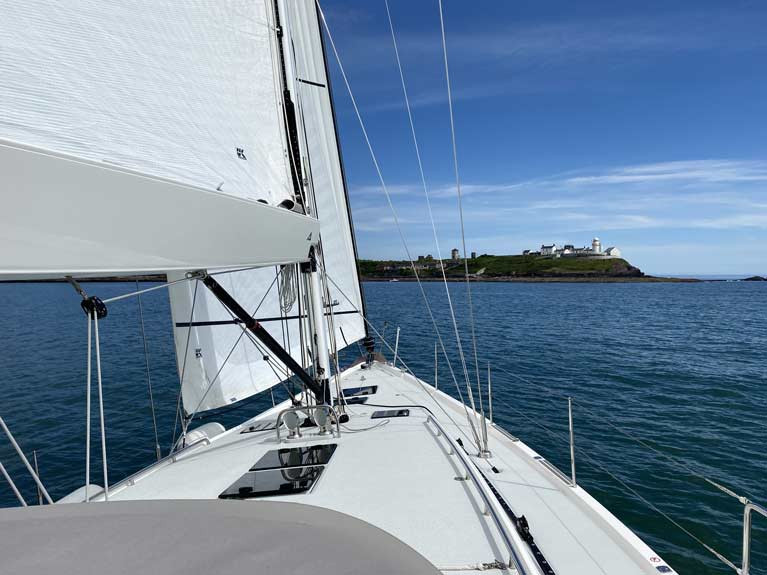Barry Hayes from UK Sailmakers Ireland gives his top tips on the backstay and using it to get the most out of your boat
Now that we are back open making and repairing sail, getting back into sailing will be foremost on everyone’s mind.
Proper application of the various controls on your boat is critical if you’re looking to get the best performance out of your boat whether sailing doublehanded or fully crewed. The backstay is one of the most important controls on a boat and can be the go-to control to quickly and easily shift from power-on or power-off modes.
Here’s what to do:
UK Sailmakers Ireland Top Backstay Tips
1. Make sure your mast is in column side-to-side in base settings. Next, having the right amount of luff curve/mast prebend is critical for properly setting-up your mainsail. To check this base setting on the dock, fully tighten your backstay and see how flat your mainsail gets. You’re looking for a flat main sail that still has power (camber) as seen in the photo below (A). You can then use the backstay as needed to bend the mast and depower the boat or straighten the mast to power up. When checking at the dock, the mast should not be over bending. Consider this your base setting with max mast bend in 8-10 kts. To add a little more camber in the main sail, tighten your diagonal (lower) shrouds and D’s. Remember, a single turn on the D’s does a lot, so go easy.
 Photo A: A flat main sail that still has power (camber) Photo: Barry Hayes
Photo A: A flat main sail that still has power (camber) Photo: Barry Hayes
2. Your boat should be fully powered up and at hull speed using your base settings in 8-12 kts. At any higher wind range, your backstay is the tool that will help you control heel and power. In this photo 'B' below, see how the leech twists open with the backstay applied. Also notice how the tip of the mast starts to sag to leeward. This happens when the middle of the mast pushes forward letting the tip fall off and there isn’t enough leech tension on the mainsail leech to pull the mast back into column. This is a common issue that diminishes performance
 Photo B - Leech twists open with the backstay applied Photo: Barry Hayes
Photo B - Leech twists open with the backstay applied Photo: Barry Hayes
3. In winds from 12 to 18, working your traveller up and down the track and putting the backstay on hard. This should give you the correct rig tune for this wind range. Be careful not to over bend the mast as it will make the mainsail too flat. The boat should be fast, pointing, with a straight forestay. You can put marks on the spreaders to see how much forestay sag you have relative to the mast bend. These marks should be viewable from the mainsheet trimmer’s seat.
4. Use the backstay to help you “shift gears” in the 12 -18 wind range, tightening it to power off and easing it to power up the mainsail. If you need to balance the boat, adjust the backstay first, the traveller second, and the mainsheet third. The reason the mainsheet is the last adjustment is that you need a tight main leech to help balance the boat and keep it pointing.
 Photo C - 12-18 kts of wind. Hiking hard, traveller down, backstay on hard and pointing well
Photo C - 12-18 kts of wind. Hiking hard, traveller down, backstay on hard and pointing well
5. Over 18 kts, its backstay on hard and leave it. To control the balance of the boat in heavier winds, you can control the amount of mainsail twist with the mainsheet and traveller. You will know you have enough backstay tension when there is almost zero forestay sag. This is critical to get the boat pointing while also maintaining power. Only ease the backstay going downwind.
6. Over 20 - 30 kts., the backstay is full-on all the time regardless of whether you’re reefed of not...upwind and down. It’s of little use easing it as it only takes time to get it back on at mark roundings. Keeping it on also stops your mast from pumping on a reach and down wind.
7. Below 8 kts. the backstay is hardly used. Only use the backstay to control forestay sag. Reduce the amount of luff curve as the boat speeds up and gets to hull speed. It’s like changing from 3rd to 4th gear in the car; adding backstay controls the sail shape and resultant speed. In this photo below, with the boat in less than 8 kts., you can see the first 50 of is fully powered up and has sufficient backstay to control the forestay sag.
 First 50 Mermaid using her Uni Titanium sails to win DL Regatta Photo: Barry Hayes
First 50 Mermaid using her Uni Titanium sails to win DL Regatta Photo: Barry Hayes
Knowing when to use the backstay controlling boat speed, heel angle and main sail shape takes experience; but these simple tips will keep your boat up to speed with the perfect sail shape and pointing angle.



























































